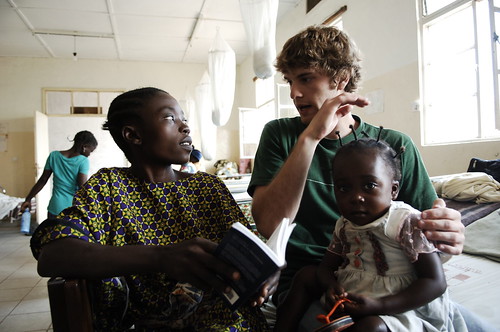Imagine yourself surrounded by a lush jungle, undulating grassland and a river that snakes around your entire village. Now imagine the serenity of your idyllic existence being shattered by gang rape and mutilation by a roving band of paramilitary rebels. Scenes like these are commonplace in the Democratic Republic of the Congo.

Women in War Zones: Sexual Violence in the Congo, a documentary that recently premiered at the National Constitution Center, explores the plight of women subjected to this type of violence. Temple alumni Brad LaBriola and Scott Blanding directed and produced the film.
The 65-minute documentary gives a sobering account of two women: 22-year-old Helene, who, at 14, was forced to choose between rape or death, and 13-year-old Bijoux, who is suffering from the effects of multiple rapes. The women met at Panzi Hospital, where they underwent surgical intervention to have their fistulas repaired.
Fistulas are abnormal passageways between organs. The fistulas are a result of rape and brutalization with knives and bayonets. They can occur between the vagina and bladder, bladder and rectum or vagina and rectum. Incontinence and infection are common for people who suffer from fistulas. The staff at Panzi Hospital work not only to repair the damage, but also to bring some normalcy to the lives of the victims.
In the film, Helene described how she was given a choice between rape and death.
“I choose neither,” she said. “Both are the same.”
Since the age of 14, Helene has not only had to endure the agony of fistulas but has also suffered through eight surgeries to correct the damage done to her body.
Bijoux, like Helene, suffers from fistulas. At the time the movie was filmed, she was undergoing her second surgery. In addition to her physical problems, Bijoux was upset about being out of school. She hopes to complete her education so she can become a nurse.
According to the documentary, thousands of women in the DRC suffer the same fate as Helene and Bijoux. Most often, they are ostracized by society. Their torn bodies make them “question their own self worth” and leave them unable to find husbands.
These women shed unseen tears, and their cries for help are often not heard. The hopelessness they are forced to endure is what prompted Blanding to film a documentary about their plight.
“[It] is the most important thing I’ve done thus far,” he said.
Blanding has worked full-time on the documentary since March 2006. Prior to filming, he researched the topic for three months.
When questioned about the presence of a women’s suffrage movement in the DRC, Blanding was unsure.
“It’s tough to say,” he said. “In the Congo, things are not well organized. Rebel groups are disorganized, the government is disorganized, and things are chaotic.”
He hopes that “bringing light to the injustices these women suffer” on a daily basis combined with “peace and stability in the region may possibly bring more opportunities for women.”
Krista Gilmore, a 2008 graduate of West Chester University, watched the documentary.
“I have heard horrible stories in my training as a social worker, but this film was chilling,” she said. “Who would think anyone could endure such inhumane treatment? I admire the women’s grit and determination.”
Blanding voiced his admiration for the women, too.
“[I was] surprised by their eagerness to talk about their trauma,” he said. “[I think they] felt a sense of validation and felt good about people wanting to hear their stories.”
Most of the crimes in this documentary were committed by Interahamwe, the Hutu rebel group from Rwanda responsible for the Rwandan Genocide in 1994. The rebels fled into the DRC to avoid capture and have plagued the country ever since. Unfortunately, the military in the DRC is unstable, so the rebel bands can rape, pillage villages, kill and cause havoc without retribution.
In the documentary, the doctors treating rape victims at Panzi Hospital also spoke about the atrocities women in the DRC are being forced to accept as a way of life.
Dr. Denis Mukwege, director of Panzi Hospital, said his examination of these women showed evidence they were “raped with knives and bayonets.”
At the beginning of 2009, Women in War Zones: Sexual Violence in the Congo will be featured during a university and church tour. Made Known LLC, the production company responsible for this documentary, is setting up a literacy aid program to empower women in the DRC.
“[It is] creating a library space in three DRC hospitals where books can be checked out in an effort to help educate these women,” Blanding said.
Denise Williams can be reached at denise.williams@temple.edu .


Be the first to comment